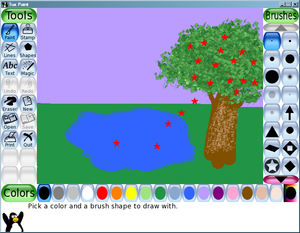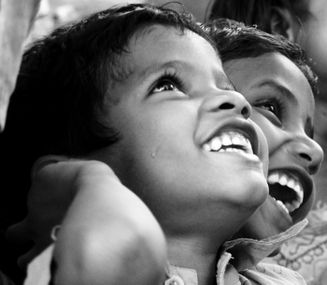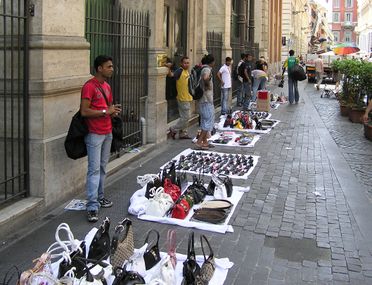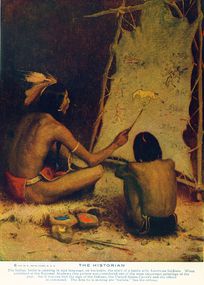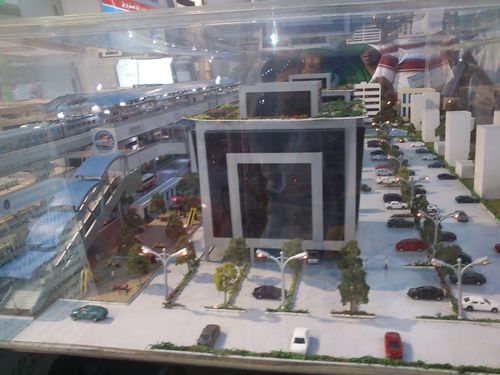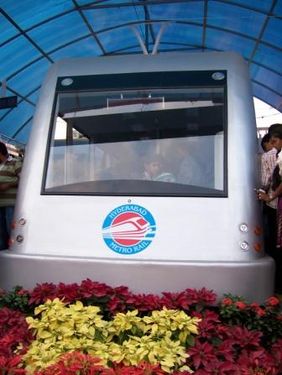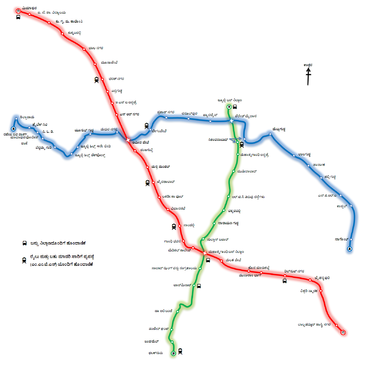Difference between revisions of "ICT student textbook/Communication with graphics"
| (21 intermediate revisions by 3 users not shown) | |||
| Line 1: | Line 1: | ||
| − | {{Navigate|Prev=Data representation and processing|Curr=Communication with graphics|Next=Audio visual communication}} | + | [http://karnatakaeducation.org.in/KOER/index.php/ಐಸಿಟಿ_ವಿದ್ಯಾರ್ಥಿ_ಪಠ್ಯ/ಗ್ರಾಫಿಕ್ಸ್ನೊಂದಿಗೆ_ಸಂವಹನ ಕನ್ನಡ]{{Navigate|Prev=Data representation and processing|Curr=Communication with graphics|Next=Audio visual communication}} |
[[File:Tuxpaint-drawing.png|thumb|A digital art creation using Tux Paint]] | [[File:Tuxpaint-drawing.png|thumb|A digital art creation using Tux Paint]] | ||
===What is this unit about? === | ===What is this unit about? === | ||
| − | A picture tells a thousand stories, they say! Have you ever wondered about how a picture can tell a story? When we hear a story, when we read a story, our mind forms an image of what is being described. | + | A picture tells a thousand stories, they say! Have you ever wondered about how a picture can tell a story? When we hear a story, when we read a story, our mind forms an image of what is being described. They make us connect to the story. Similarly, when we see a picture, our mind tries to build the story from the picture. No wonder that picture story books are favourite reading books for children and adults. |
| − | In this unit, we will learn how we can use pictures as a method of story telling. | + | In this unit, we will learn how we can use pictures as a method of story telling. Story telling is a traditional method of transmitting information from one person to another; one generation to another. Story telling can also be used to create awareness about social issues and challenges - talk to your teacher about how [[wikipedia:Burra_katha|Burra Katha]] emerged as an art form in Telangana. Drawing pictures is also not new. Human beings have been using pictures to tell stories, describe things throughout our history - from cave paintings to [[wikipedia:Deccan_painting|Deccani paintings]] to the comic strip or to the movie poster. |
| − | Can you guess what is new about this unit? Yes, it is the use of new, digital methods to create pictures and combining them with text. | + | Can you guess what is new about this unit? Yes, it is the use of new, digital methods to create pictures and combining them with text. This field of ICT involving the creation of visual (pictures and text) stories is called [[wikipedia:Graphics|graphics]] and is developing fast as a method of developing communication. In the earlier unit on data processing, you saw how data is represented in multiple formats - through text, numbers, and maps, photos and pictures. |
| − | In this unit, we will focus on how we can use digital methods to create such graphic representations. | + | In this unit, we will focus on how we can use digital methods to create such graphic representations. You will be creating with ICT, interacting with various ICT applications and devices and developing messages for communication. |
| − | + | ===={{font color|purple|''The beginning of photography!''}}==== | |
| − | {| | + | Your teacher will show you the following video to give you an idea of how photography began. Watch the times shown, how people lived and worked. In your home or local neighbourhood, find out if there are any old photographs. <br> |
| − | + | ||
| − | + | {| | |
| − | |||
|- | |- | ||
| − | | | + | |{{Youtube|sOkd8ObhN_M}}|} |
| − | + | ||
| − | + | ===={{font color|purple|''Telling stories with pictures - 1''}}==== | |
| − | + | <gallery mode="packed" heights="190px" style="text-align:left"> | |
| + | File:Animals in action; studies and stories of beasts, birds and reptiles; their habits, their homes and their peculiarities (1901) (14568810978).jpg|'''Picture for discussion - 1''' | ||
| + | File:Smiles of innocence.jpg|'''Picture for discussion - 2''' | ||
| + | File:Street.hawker.in.rome.arp.jpg|'''Picture for discussion - 3''' | ||
| + | File:The_How_and_Why_Library_002.jpg|'''Picture for discussion -4''' | ||
| + | </gallery> | ||
| + | |||
| + | What ideas come into your mind when you see the pictures? Discuss with your friends what ideas came into their mind. You may have come to the understanding that pictures can tell stories in many ways: | ||
| + | # Show how we feel | ||
| + | # Describe events | ||
| + | # They can sometimes express ideas beyond words | ||
| + | # A picture can be a substitute for an experience - you can understand the event even if you have not seen or heard it directly | ||
| + | # Combined with words | ||
| + | |||
| + | ===={{font color|purple|''Telling stories with pictures - 2''}}==== | ||
| + | |||
| + | <gallery mode="packed" heights="200px" style="text-align:left"> | ||
| + | File:Lnt-metrorail-hyderabad-girder.jpg|'''Metro Rail Progress Picture 1''' | ||
| + | File:Hyderabad Metro Rail Project - Progress.jpg|'''Metro Rail Progress Picture 2''' | ||
| + | File:HYD Metro near SC.jpg|'''Metro Rail Progress 3''' | ||
| + | </gallery> | ||
| + | |||
| + | <gallery mode="packed" heights="250px" style="text-align:left"> | ||
| + | File:Station model of Hyderabad Metro at Nampally Exhibition.JPG|'''Metro Rail Progress Picture 4''' | ||
| + | File:Hyderabad Metro Engine.JPG|'''Metro Rail Progress Picture 5''' | ||
| + | File:Hyderabad Metro Rail.png|'''Metro Rail Progress Picture 6''' | ||
| + | </gallery> | ||
| + | |||
| + | Look at these pictures and discuss with your friends: | ||
| + | #What do these pictures represent? | ||
| + | #Are they in any order? Should the order be changed? Will that help you talk about the metro better? | ||
| + | #If someone were to ask you to tell about Hyderabad Metro Rail in photos, would you use these pictures or would you want to take some more pictures? What would you have to do before you start collecting the pictures? | ||
===Objectives=== | ===Objectives=== | ||
| − | + | #Understanding the power of story telling as a method of communication and that pictures can tell stories | |
| − | + | #Understanding how to tell a story - developing a story board and determining how/ when to introduce different elements – text, images, designs | |
| − | # | + | #Creating digital art |
| − | # Creating digital art | + | #Accessing images and pictures from the internet |
| − | # | + | #Creating a graphic communication - combining images and text |
| − | # Creating a graphic communication - combining images and text | ||
=== How is the unit organized === | === How is the unit organized === | ||
In this unit, similar to the previous units, you will work on activities at three levels. Broadly the levels are divided in terms of the following skills: | In this unit, similar to the previous units, you will work on activities at three levels. Broadly the levels are divided in terms of the following skills: | ||
| + | #At level one, you will focus on compiling pictures and reading them to tell a story | ||
| + | #At the second level, you will create pictures with digital tools and learn to illustrate stories and songs | ||
| + | #At the third level, you will develop a story sequence, look for suitable images, or create suitable images, and combine with text to create your own posters, comic strips and story books | ||
| − | + | *The examples for graphics creation will be drawn from your textbook and will be related to different topics you have studied. You would have learnt to type in Telugu and make a concept map in the activities in the data representation and processing unit. You would have also learnt to make simple documents with a text processor. All these skills you will learn in the unit on data representation and processing will help you develop your graphic communication. | |
| − | + | *You will continue to add to your portfolio. You should look at your portfolio as a library for learning various subjects. This theme also will be covered across classes 6,7 and 8 through the following three levels, respectively. | |
| − | |||
| − | |||
| − | |||
| − | + | ==== [[ICT student textbook/Communication with graphics level 1|Communication with graphics level 1]] ==== | |
| − | + | ==== [[ICT student textbook/Communication with graphics level 2|Communication with graphics level 2]] ==== | |
| − | + | ==== [[ICT student textbook/Communication with graphics level 3|Communication with graphics level 3]] ==== | |
Latest revision as of 03:52, 8 February 2024
What is this unit about?
A picture tells a thousand stories, they say! Have you ever wondered about how a picture can tell a story? When we hear a story, when we read a story, our mind forms an image of what is being described. They make us connect to the story. Similarly, when we see a picture, our mind tries to build the story from the picture. No wonder that picture story books are favourite reading books for children and adults.
In this unit, we will learn how we can use pictures as a method of story telling. Story telling is a traditional method of transmitting information from one person to another; one generation to another. Story telling can also be used to create awareness about social issues and challenges - talk to your teacher about how Burra Katha emerged as an art form in Telangana. Drawing pictures is also not new. Human beings have been using pictures to tell stories, describe things throughout our history - from cave paintings to Deccani paintings to the comic strip or to the movie poster.
Can you guess what is new about this unit? Yes, it is the use of new, digital methods to create pictures and combining them with text. This field of ICT involving the creation of visual (pictures and text) stories is called graphics and is developing fast as a method of developing communication. In the earlier unit on data processing, you saw how data is represented in multiple formats - through text, numbers, and maps, photos and pictures.
In this unit, we will focus on how we can use digital methods to create such graphic representations. You will be creating with ICT, interacting with various ICT applications and devices and developing messages for communication.
The beginning of photography!
Your teacher will show you the following video to give you an idea of how photography began. Watch the times shown, how people lived and worked. In your home or local neighbourhood, find out if there are any old photographs.
Telling stories with pictures - 1
What ideas come into your mind when you see the pictures? Discuss with your friends what ideas came into their mind. You may have come to the understanding that pictures can tell stories in many ways:
- Show how we feel
- Describe events
- They can sometimes express ideas beyond words
- A picture can be a substitute for an experience - you can understand the event even if you have not seen or heard it directly
- Combined with words
Telling stories with pictures - 2
Look at these pictures and discuss with your friends:
- What do these pictures represent?
- Are they in any order? Should the order be changed? Will that help you talk about the metro better?
- If someone were to ask you to tell about Hyderabad Metro Rail in photos, would you use these pictures or would you want to take some more pictures? What would you have to do before you start collecting the pictures?
Objectives
- Understanding the power of story telling as a method of communication and that pictures can tell stories
- Understanding how to tell a story - developing a story board and determining how/ when to introduce different elements – text, images, designs
- Creating digital art
- Accessing images and pictures from the internet
- Creating a graphic communication - combining images and text
How is the unit organized
In this unit, similar to the previous units, you will work on activities at three levels. Broadly the levels are divided in terms of the following skills:
- At level one, you will focus on compiling pictures and reading them to tell a story
- At the second level, you will create pictures with digital tools and learn to illustrate stories and songs
- At the third level, you will develop a story sequence, look for suitable images, or create suitable images, and combine with text to create your own posters, comic strips and story books
- The examples for graphics creation will be drawn from your textbook and will be related to different topics you have studied. You would have learnt to type in Telugu and make a concept map in the activities in the data representation and processing unit. You would have also learnt to make simple documents with a text processor. All these skills you will learn in the unit on data representation and processing will help you develop your graphic communication.
- You will continue to add to your portfolio. You should look at your portfolio as a library for learning various subjects. This theme also will be covered across classes 6,7 and 8 through the following three levels, respectively.
